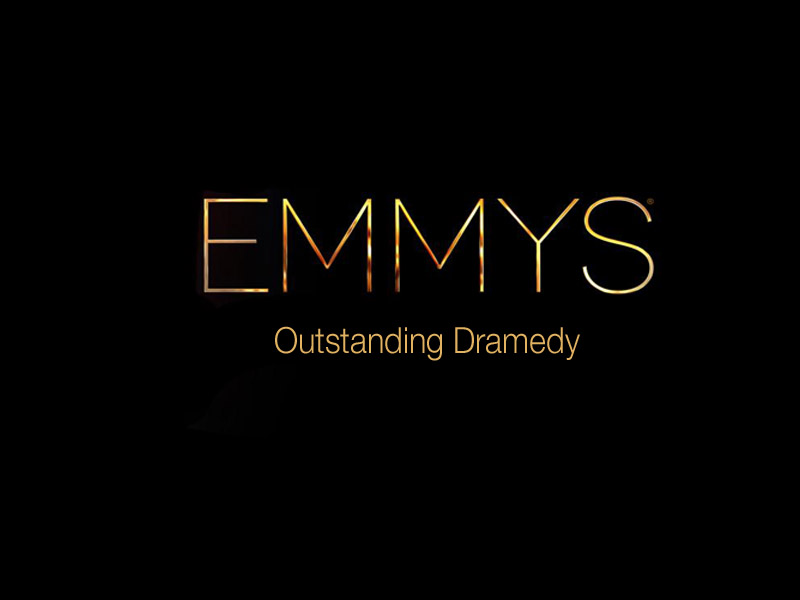Neil Landau shares his thoughts with Creative Screenwriting on the changing TV landscape and the popular hybrid genre format, the dramedy. A must-read for TV writers.
HOW DOES NETWORK TV SCHEDULE TV SHOWS?
Is it a comedy or a drama?
Or is it a genre-bending dramedy?
I say, as long as it’s good, does it matter?
It depends on whom we ask. For the broadcast and basic cable TV networks that are still scheduled in rigid timeslots and beholden to advertisers and commercial breaks, categorization still matters a lot. It’s either comedy or drama, with nothing in between.

Will and Grace
At NBC, where everything old is new again, scheduling TV sitcoms in comedy blocks on the same night continues to be a viable programming strategy. Tune in Thursdays and we’ll have a night of laughter, anchored by their reboot of Will & Grace. ABC, CBS and Fox all program their sitcoms in compatible pairs, presuming that if we’ve tuned in to Modern Family or Mom, we’re probably going to stick around for the complementary shows that follow.
Broadcast television networks still need to fill their primetime schedules with series that work in particular timeslots, and they’ll often utilize a proven ratings hit as a launching pad for a new show. Traditionally, the 8:00 to 9:00 p.m. timeslot has been called the “family hour” and offers softer-edged shows that appeal to the whole family, followed by more sophisticated sitcoms and reality TV at 9:00 p.m. and darker, harder-edged crime, legal and/or medical procedurals in the 10:00 p.m. timeslot.

The Resident
But besides sports and live events, who even bothers to watch TV in timeslots anymore? The answer is twofold:
1. Generally, viewers over the age of 40.
2. Viewers who can’t afford a subscription to a streaming, on-demand service and/or those who simply prefer free TV.
Will & Grace is a classic sitcom which got a revival bolstered by the tug of nostalgia. The multi-camera hit series The Big Bang Theory (from the fertile imagination of TV’s successful funnyman, Chuck Lorre) still garners large ratings for CBS (its 2017 season finale scored more than 12.5 million viewers). Nevertheless, its prequel/spinoff, entitled Young Sheldon, is shot single-camera style—without a live studio audience. This delightful dramedy has more in common with nostalgic series The Wonder Years than with its mothership laugh riot sitcom The Big Bang Theory.
Is this a sign of the times that the multi-camera sitcom is on the wane? It’s alive but leaning in that direction, as TV shows have become more cinematic and less static/contained. The big ratings numbers of Big Bang Theory certainly attest to audiences’ enjoyment of three-jokes-per-page traditional sitcoms—especially if the jokes are funny. But having the freedom to follow characters outside of large apartments, office spaces and coffeehouses tends to feel more liberating and surprising. If the characters can go anywhere and not be limited to two “permanent” sets and a “swing” set (an interchangeable set depending on that week’s episode), the episode can feel more organic and authentic—like life.
Like the dramedy that’s between genres, viewers today fall somewhere between traditional and online platforms. NBCUniversal’s niche digital comedy network Seeso announced its closure at barely 19 months old, having struggled to win subscribers. Some Seeso Originals moved to streaming service VRV, while comedies on NBC’s traditional broadcast network continue to flourish. Perhaps Seeso was ahead of its time.
WHAT DIFFERENTIATES A DRAMEDY FROM A COMEDY?
Norman Lear pushed the envelope on his classic multi-camera sitcoms in the 1970s (All in the Family, The Jeffersons, Maude, Good Times, One Day at a Time) by balancing laugh-out-loud jokes and funny situations in front of a live studio audience, while also dealing with the controversial issues of race, religion, gender and politics. But Lear went even further with more personal dramatic storylines that encompass divorce, infidelity, cancer, abortion and even rape. These more serious episodes were the exception, not the rule. The broadcast networks have always been more comfortable with funny comedies (with heart) and emotionally resonant dramas with (easily solvable) moral dilemmas.
Most dramedies are not giant ratings champs, but they do have a fiercely loyal, niche fan base. If authenticity is the most desired commodity in the digital TV era, then the dramedy hits that sweet spot by getting real, and rarely sacrificing a raw, emotionally impactful moment for an easy laugh. Recent examples include Baskets, Casual, Crazy Ex-Girlfriend, Insecure and Transparent.

Multi-camera sitcoms are, by design, formulaic, familiar and reassuring and must be funny. If the table read in front of the network and studio executives doesn’t generate consistent laughs, the writers will need to stay up all night rewriting the script. A multi-camera sitcom with flat jokes is deadly.
Single-camera sitcoms also need to generate laughs, but through funny, ironic situations and character quirks, more than punchlines. Of course, single-cam sitcoms are also required to be funny.
A sitcom with fewer jokes is . . . what? That depends. It could be a bad sitcom, or it could be a version of the seminal, genre-bending, tone-blurring dramedy series—either half-hour or one-hour.
Good rules of thumb…
MULTI-CAMERA SITCOM: Half-hour. Funny is money. Mainly interiors, 2–3 main sets; lots of entrances and exits from rooms. Minimum of 3 jokes per page (setups and punchlines); escalate chaos to solve a small problem writ large (a/k/a “tremendous trifles”); restore stasis and love by the end of the episode. A/B/C stories usually have a unifying theme. Little to zero character development. Examples: The Big Bang Theory, Two and a Half Men, Fuller House, One Day at a Time.
SINGLE-CAMERA SITCOM: Half-hour. Mixture of jokes and funny situations. Approximately 60/40 split between interiors and exteriors; humiliate the protagonist(s) and challenge their comfort zones; restore stasis and love by the end of the episode; flashbacks and flash cuts to past moments of embarrassment are employed for comedic effect. Mockumentary and confessionals (a/k/a breaking the fourth wall) are sometimes employed. Usually have a unifying theme. Little, no or slow character development. Modern Family, Silicon Valley, Brooklyn Nine-Nine, Unbreakable Kimmy Schmidt, The Good Place, The Last Man on Earth, Black-ish, Veep, Curb Your Enthusiasm, Grace & Frankie, Ballers and Fresh Off the Boat as well as Ricky Gervais’ groundbreaking comedy/dramedy series including The Office, Extras and Derek.
DRAMEDY: Half-hour or one-hour. Honest, raw, uncomfortable relationship issues are explored with nuance and subtext. Generic and familiar plotlines are eschewed entirely. The tone can be funny or tragic but is intentionally off-putting, especially when offering an inconvenient truth. Characters have hyper-specific personality quirks and are more psychologically and emotionally complex. Characters tend to make irrational decisions and are less likable. Avoid formula, with each episode individually crafted to feel distinctive and one-of-a-kind. Can be expansive and cinematic, often featuring multiple locations and fragmented plotlines; usually have an indie movie sensibility and avoid mainstream, obvious/manipulative music choices; the visuals tell the story more than expositional dialogue; usually tell the story in the cut to create a tapestry of interwoven storylines; particular music, montages, flashbacks, voice-over, fantasies and magic realism might be utilized. Thematic through-lines may unify each episode, but more likely there’s a season-long theme. Most dramedies are heavily serialized and utilize DPUs from episode to episode.
DRAMEDIES AND LIFE ON THE CRINGE
The pure dramedy may serve up a wholly serious episode, followed by a more broadly comedic one. There’s less of a consistent comedic or dramatic tone, and more of the creator’s sensibility. Authenticity trumps easy laughs. Subtext and nuance are mined for maximum cringe and relatability. If traditional sitcoms are about likably flawed characters getting into and out of trouble, then dramedies are more about coping with the ongoing hardships and moral complexities of relationships.
Sitcoms generally offer well-intentioned characters caught up in their own self-generated chaos; they offer up a problem and a solution—or moral—by the end of the episode.
Dramedies are generally much more ambiguous, and their characters tend to be self-involved, self-destructive, and while forgiveness and love are still the currency required to solve a dilemma, dramedies don’t offer up easy answers.
My new book TV WRITING ON DEMAND: CREATING GREAT CONTENT IN THE DIGITAL ERA presents an analysis of a selection of the best recent dramedies. Without the bitter, there’s no context for the sweet. Without struggle, the reward feels empty or tinged with fear that it’s unsustainable. The best dramedies demonstrate the interstices in our lives. The ellipsis between a dissatisfied “here” and some abstract or idealized notion of “there.” We tend to watch TV during our own interstices, and for varied reasons—to pass the time, for distraction, for inspiration—and yes, escape. Seeing fictional characters who are as uniquely flawed as we are also treading water is comforting. We identify with characters who are always yearning and waiting for the next big thing. But every moment matters and even the insignificant ones are significant in a great half-hour dramedy. It’s the accumulation of the smallest details and the struggle between the repression and expression of emotions that pulls us in and keeps us invested in the outcome. In several respects, the dramedy has flourished because it’s like life.

